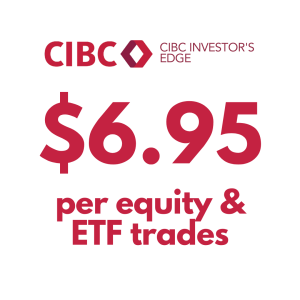
Investing is an important aspect of personal finance as a whole. Of course, there are other important factors too, like budgeting and paying down debt. But once you’ve mastered these things, you’ll eventually build enough savings to put into an investment. Why is investing important, you ask? There are several reasons, but the main ones are to allow your money to grow passively and to save for big life goals, like buying a house, retirement, or achieving financial freedom. If you’re new to investing, you may wonder how to start investing in Canada with a little money. Even if you have ample savings set aside for investment purposes, beginners can still learn something from this article. Keep reading to learn more about how to start investing in Canada!

Table of contents
How much money do I need to start investing in Canada?
In the past, there were minimum investment requirements on trading platforms in Canada. But with modern platforms like Questrade and Wealthsimple, you can start investing with as little as $10. However, you likely won’t be able to earn much in investment income unless you begin with at least $1,000. Ultimately, there isn’t a minimum investment amount, but the more you invest, the greater your returns will be.
CIBC Investor’s Line Offer
Up to $6.95 per online stock or ETF trade. Plus, there’s no minimum account balance.
At the same time, it’s important to assess your overall financial situation before deciding how much to invest. For instance, you should have enough cash flow to cover your expenses and have an emergency fund. In other words, you shouldn’t over leverage your finances or go into debt to begin investing. Rather, you should be in a stable financial position and begin investing your excess cash and savings. Otherwise you might end up in a situation where you have to prematurely liquidate your investments to cover the cost of living or pay off debt.
Ideally, you should have control over your investments and only sell them when it makes sense for you and your portfolio. In addition, you should eliminate debt, build an emergency fund and develop healthy financial habits before beginning your investing journey. If you aren’t sure where to start, consider performing a financial health check on yourself and creating appropriate financial goals.
Related Reading: How To Invest $1000, $10,000 Or $100,000
How much should I invest as a beginner?
As a beginner, a good starting point is to invest somewhere between $1,000 and $5,000. This is considered a little bit of money in the world of investing. It may not be a little to you, but compared to market capitalizations in the stock market, it’s not much! In addition, investment portfolios can grow to be in the hundreds of thousands, so a couple thousand is a good starting point.
When one begins investing, it’s usually because they’ve gotten themselves into a good financial position and have some idle money in a savings account. At this point, it’s a good opportunity to put those savings to work so you can earn interest and investment income. Instead of the money sitting in an account, not earning passive income, thereby doing nothing for you. Ultimately, if your money isn’t growing in pace with inflation, at the very least, then you’re losing money!
As mentioned above, you can start investing with as little as $100, or even $10, not necessarily $1,000. But you won’t have the opportunity to earn a lot of money without putting in a substantial investment. The more you give, the more you get in returns.
Related Reading: 9 Investments that Pay You Every Month
How to invest $1,000 dollars in Canada?
There are ample ways to start investing with only $1,000. Before we get into this, let’s quickly review investing within a tax-sheltered account.
In Canada, we have access to powerful tax accounts, such as the Tax-Free Savings Account (TFSA), Registered Retirement Savings Plan (RRSP), Tax-Free First Home Savings Account (FHSA) and more. Normally, if you earn interest, income from dividends or other investment income, or realize a capital gain, you owe tax on that money. However, these accounts either shelter or defer tax from your investment income. When starting your investing journey, it can be helpful to start investing within a tax-sheltered account. This way you can learn the ropes of investing before considering the element of tax. Further, it’s best to max out the contribution room of any tax-sheltered accounts you have access to before opening a non-registered investing account.
Related Reading: TFSA vs RRSP: Where To Put Your Money
Let’s take a look at some options on how to invest $1,000 in Canada below. Keep in mind you may be able to exercise these options with less money, like $250 or $500, but it depends. Some investments or providers may have minimum commitments or high prices.
1. Guaranteed Investment Certificates (GICs)
A guaranteed investment certificate, or GIC for short, involves investing money with an institution, typically a bank. In exchange for your money, the institution will pay you interest for a specified period of time. At the end of the agreed upon period, your principal, plus any outstanding interest, is paid back to you.
These types of investments are very low risk which is why they’re “guaranteed”. However, the rate of return isn’t as high as other investments. Most institutions have a minimum investment requirement of $1,000, but some may have lower requirements.
2. Bonds
Bonds are offered by governments or corporations. It is a form of equity financing these institutions use to raise capital for the growth of their operations. Bonds work similarly to GICs. Although, the risk is higher than with a GIC, but the rate of interest tends to be higher as a result.
Related Reading: How to Buy Bonds in Canada
3. Treasury Bills
Treasury bills, or T-bills for short, are short-term debt securities. They are offered by the Canadian government, and other governing entities around the world, to finance their operations and growth. Similar to a bond or GIC, an investor lends money to the government and receives their principal, plus interest, at the end of the agreed upon term.
Related Reading: How to Buy Treasury Bills in Canada
4. Mutual Funds
A mutual fund consists of pooled investments that are overseen by a professional fund manager. For this reason, mutual funds are “actively managed” and charge a management fee for this service. Naturally, this fee cuts into your investment profits, so be wary.
Many investors will put money into the mutual fund, then the sum of money will be invested based on the fund’s goal. Mutual funds can have an array of goals, such as to invest in a particular sector, or to track or outperform a specific index. Often, mutual funds have investment minimums, some as low as $1,000, but may have restrictive criteria around withdrawals.
Related Reading: How to Invest in Mutual Funds in Canada
5. Stocks
Stocks represent a share of a company that is publicly traded. In other words, you own a small percentage of the company.
When a corporation goes public, meaning they issue an Initial Public Offering (IPO), they offer stocks on a publicly traded exchange. Throughout the day, investors can buy and sell shares of companies. This activity causes the price of the underlying stock to fluctuate. In addition, the company’s decisions and operations can impact the stock’s value and price on the open market.
Related Reading: How To Invest In Stocks
6. Exchange-Traded Funds (ETFs)
Exchange-Traded Funds, or ETFs for short, are similar to stocks because they can be bought and sold on a public stock exchange. But instead of investing in a specific company, you’re investing in a basket of investments, usually within a particular sector or to track a certain index. These can be a good starter investment because you can access numerous stocks and holdings with one purchase.
Related Reading: ETFs vs Mutual Funds: Which is Better?
How to Start Investing in Canada with a Little Money
Whether you’re starting with $10, $100 or $1,000, here’s a step by step process on how to start investing in Canada:
Step 1: Decide on an Investment Amount
Before anything, you need to determine how much money you’ll actually be investing. Remember, you should use idle savings for investment purposes, not money from an emergency fund or cash flow. In addition, you shouldn’t take on debt to invest or begin investing when you’re not yet debt free. Ultimately, you should invest money you have saved, but don’t need for anything else, even if it’s only a little!
Related Reading: Types of Investment Accounts in Canada
Step 2: Select Your Investment
Next, select the investment you’d like to purchase, may that be a GIC, mutual fund, stock, or otherwise. This can be tricky if you’re a beginner. It’s helpful to consider your risk tolerance, financial goals and interests. In addition, consider your investment amount. Some investments might not be in your reach yet based on how much you’re planning to invest.
Some people don’t want to gamble their money, so they choose safer investments like GICs and bonds over stocks and ETFs. Further, some Canadians may want to save and invest for a down payment and need to grow their money quickly. Thus, they choose to commit to riskier, high growth investments. But on the other hand, some may simply want to save for retirement and would rather buy and hold stocks for long periods of time. This way, they can capitalize on long term gains.
Finally, your specific interests matter in investing too. If you know a lot about the healthcare industry, you should consider an investment in this sector over one you know nothing about. As Warren Buffet famously said, “Never invest in a business you cannot understand.”
If you’re starting with a little money, you’ll probably only invest in one thing to begin. When you have more idle cash down the road, you can repeat this process. So, choose one investment wisely for now!
Related Reading: Investment Ideas in Canada
Step 3: Choose a Investment or Trading Account
Once you know the investment you want to make, it’s time to prepare for the purchase. Usually this involves some sort of investment or trading account, or applying for the financial product with the appropriate institution.
During the process of selecting an investment, you should determine how to actually purchase the investment too. For instance, if you want to buy a GIC, you’ll likely choose a product with a specific bank which will have details on how to apply for the product. Or, if you’re wanting to buy a stock, mutual fund or ETF, you’ll need to open a trading account with your bank to access the exchange.
If you’re ever unsure, reach out to your bank or a financial advisor for guidance!
Step 4: Purchase the Investment
When you’ve got your trading account open or know how to apply for the product, it’s time to complete the purchase. Make sure you have the account funded or the cash available to facilitate the transaction. Then, all that’s left is to purchase the investment!
Step 5: Track and Assess Performance
The thing about investing is that it takes time. If we all could get rich tomorrow, we would! However, it takes time for money to grow and even more time to perfect your approach as an investor.
With your initial investments, be sure to track the performance and assess if it met your expectations and goals. If it did, then great! Apply that same logic to your next investment. If not, don’t fret, this is the best learning experience. Understand what went wrong, learn from the mistake and apply it to your next investment. At the end of the day, you will make mistakes, just be sure to learn and grow from them!
Related Reading: How To Invest Your Money
What are the safest investments in Canada?
Generally speaking, the safest investments in Canada are guaranteed investment certificates, bonds and treasury bills. These usually have a reliable return and you can expect to receive your investment income on a specific date. Furthermore, they are issued by reliable entities, like banks, government bodies, and established corporations. For this reason, the risk of losing your initial investment is low. The only drawback with these safe investments is a lower rate of return. The higher the risk, the higher the return and vice versa.
With that being said, investors can also find safe, low risk investments with mutual funds, stocks and ETFs as well. Just be sure to keep your risk tolerance and financial goals in mind when doing your research and making decisions.
Related Reading: 10 Best Stocks for Beginners in Canada
Beginning Your Investing Journey
You’re at a point in your financial journey where you have available cash to invest. First things first, congratulations! It can take quite a bit of time to balance your income and expenses, devise and follow a budget, eliminate debt, and establish healthy financial habits. Even if you’re starting to invest with a little money, this is no easy task and you should be proud of yourself for getting this far. Now, it’s time to take the next step and begin your investing journey. Challenges lie ahead, but you’ve come this far, so don’t stop the momentum!
When beginning your investing journey, make sure to always consider your risk tolerance and financial goals. This will help you navigate difficult investing decisions and make the right choice for you and your portfolio. If you find yourself in need of support or guidance, a financial advisor can help. Complete this quick questionnaire to be matched with one today!
Read More: Best Investing Books For Canadian Investors


